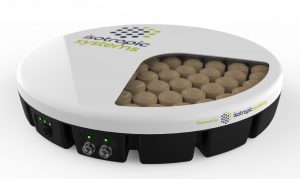
The second phase tests were carried out in conjunction with SES, the Luxembourg-headquartered satellite telecommunications provider, and the UK company declared this “a game-changing development empowering a new age of connectivity” on land, air and sea, for both civil and defense communications.
Isotropic’s technology underwent a series of field tests at SES’s Manassas, Virginia teleport. The terminal established multiple simultaneous, full-performance link connections with SES satellites. It linked to a geostationary (GEO) satellite while simultaneously connected with an O3b satellite in medium earth orbit (MEO).
“We have removed the major bottleneck holding back the expansion of the satellite sector for both commercial and defense communications. Users can finally connect to as many satellites as they want, when they want, wherever they want and that’s a game-changer for enterprise, aero, maritime, government and defense,” said John Finney, founder and CEO of Isotropic Systems.
“This test proves space is now open, as we mesh networks together in a way that is unparalleled, without compromise. We have delivered on our vision to combine the full performance of multiple antennas into one multi-link, solid state, software defined terminal without any restrictions.”
Mike Rudd, the Head of Telecommunications Strategy at the UK Space Agency (UKSA), was among those praising the progress of Isotropic. The company has previously been backed by the UKSA.
“This is a significant breakthrough that will put UK technology developed by Isotropic Systems at the heart of meeting the unprecedented demand for global connectivity. It’s a great example of the innovation found within the UK’s growing space sector and has been made possible by our leading investments in telecommunications research through the European Space Agency.”
Isotropic plans to support new satellites launching in GEO, HEO, MEO and LEO orbits from 2022 onwards.
First phase tests
First phase dual-beam tests were successfully conducted at the Harwell Science, Technology and Innovation Campus near Oxford back in June, reported SES at the time. These tests were explicitly in conjunction with the US military, investigating the multi-link technology.
“Next-gen satellites and constellations need equally robust and resilient terminals and ground infrastructure to meet the government’s ’Fighting SATCOM’ vision,” said Pete Hoene, President and CEO of SES Government Solutions, Brigadier General, USAF (Ret.), quoted in June.
“Interoperability and multi-orbit capabilities are essential to achieving this vision, and these collaborative trials with the armed forces demonstrate how Isotropic Systems’ multi-beam antenna can successfully deliver robust connectivity across our vast MEO and GEO fleet. Each successful phase is a prime example of how the government and commercial partners can develop capabilities in parallel, which is especially important to us as we ready to launch our O3b mPOWER constellation and SES-17 satellite this year.”
See also: ESA signs UK’s Isotropic for next-gen satellite connectivity